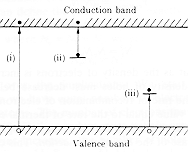|
A
semiconductor is a material with a temperature dependent resistance that
tends to infinite values as temperature tends to zero Kelvin and to low
values at room temperature and above. Semiconductors may be elemental,
such as silicon and germanium, or compounds such as gallium arsenide and
tin oxide.
The
electrical conductivity of semiconducting materials depends on the number
and type of carriers, their charge and mobility. Conductivity takes place
through the motion of electrons in the conduction band and holes in the
valence band of the pure, "intrinsic," semiconductor. If impurities are
added to the material, extrinsic electrons or holes may dominate the conductivity
making the material n-type or p-type respectively. The diagram illustrates
this, the energy of the electrons being plotted vertically and position
in the material horizontally.
The
probability of thermally exciting a carrier from a localized state to the
free state is just the Boltzmann probability P = exp(-DE/kT).
For (i) DE
is about 1 eV, for (ii) and (iii) DE
is about 0.1 eV. |
|
|
|
|
|
|
